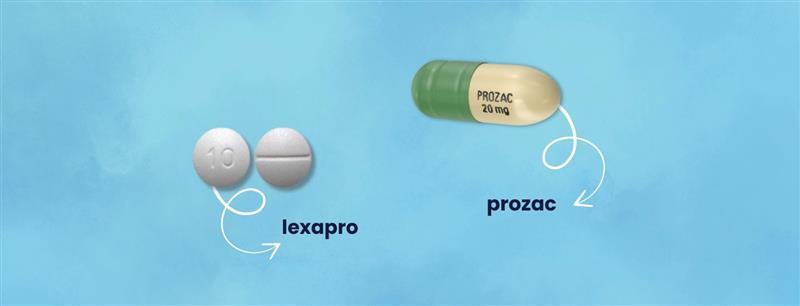Lexapro vs. Prozac: Understanding Key Differences and Effects
Choosing the right antidepressant can be overwhelming, especially when you’re already dealing with depression or anxiety. Lexapro (escitalopram) and Prozac (fluoxetine) are two of the most commonly prescribed antidepressants, classified as selective serotonin reuptake inhibitors (SSRIs). Though they belong to the same drug class and treat similar conditions, they differ in several important ways that… Read more

Reviewed by Saira Hemani, PA-C
Staff Provider at PsychPlus
July 10, 2025

Choosing the right antidepressant can be overwhelming, especially when you’re already dealing with depression or anxiety. Lexapro (escitalopram) and Prozac (fluoxetine) are two of the most commonly prescribed antidepressants, classified as selective serotonin reuptake inhibitors (SSRIs). Though they belong to the same drug class and treat similar conditions, they differ in several important ways that may make one a better choice for you. This guide provides a detailed, evidence-based comparison to help you understand how they work, what they treat, and what to expect in terms of side effects, safety, and accessibility.
Medical Disclaimer: This article is for informational purposes only and is not a substitute for professional medical advice, diagnosis, or treatment. Always consult your physician or a qualified health provider with any questions you may have regarding a medical condition.
Lexapro vs. Prozac: What Conditions Do They Treat?
Approved Uses for Each
Lexapro is FDA-approved for the treatment of Major Depressive Disorder (MDD) in adults and adolescents ages 12 to 17, as well as for Generalized Anxiety Disorder (GAD) in adults and children ages 7 and older [9].
Prozac, on the other hand, has a broader range of FDA-approved treatment uses. It is approved for MDD, Obsessive-Compulsive Disorder (OCD), Bulimia Nervosa, Panic Disorder, and Premenstrual Dysphoric Disorder (PMDD) [10]. This broader scope makes Prozac a common choice for patients with overlapping psychiatric or behavioral concerns.
Common Off-Label Applications
Both SSRIs are also prescribed off-label for additional conditions. Lexapro is often used off-label for Panic Disorder, Post-Traumatic Stress Disorder (PTSD), and PMDD [2]. Prozac has additional off-label applications in treating Social Anxiety Disorder, PTSD, and even Anorexia Nervosa [10].
Note on Off-Label Use: Off-label use refers to the prescription of a drug for a condition not explicitly approved by the FDA. While off-label uses are often supported by clinical evidence and physician experience, they should be pursued only under the guidance of a licensed healthcare provider.
How Lexapro and Prozac Work to Improve Mood
The Role of Serotonin in Mental Health
Both medications work by increasing serotonin availability in the brain, a neurotransmitter integral to regulating mood, anxiety, and emotional balance [7]. This mechanism helps alleviate symptoms of various mental health disorders.
What Makes Each SSRI Slightly Different
Despite sharing a mechanism of action, the two medications differ in important pharmacologic characteristics. Lexapro is the S-enantiomer of citalopram, offering high selectivity for serotonin transporters, which may lead to better efficacy and fewer side effects in some patients [5]. Prozac has a notably long half-life, making it more forgiving for missed doses but potentially slower to act and more persistent in the body during discontinuation [9].
Side Effects of Lexapro vs. Prozac: What to Expect
Shared Side Effects
Lexapro and Prozac have overlapping side effects, including nausea, headache, dry mouth, insomnia, and sexual dysfunction [6]. These are typically mild and resolve with continued use, but can vary in intensity among patients.
Differences in Tolerability and Symptom Impact
Lexapro tends to be better tolerated, with lower incidence of side effects like jitteriness or increased anxiety. A comprehensive network meta-analysis reported escitalopram as among the most efficacious and tolerable SSRIs for MDD [2]. Prozac, while effective, may lead to more agitation or restlessness in some patients, especially early in treatment.
Lexapro vs. Prozac: How to Take Them Safely
Dosage Forms and Frequency
Lexapro is available in 5, 10, and 20 mg tablets and as a 5 mg/5 mL solution, taken once daily. Prozac comes in 10, 20, and 40 mg capsules, a 90 mg delayed-release weekly capsule, and a 20 mg/5 mL solution [3].
What to Know About Starting or Stopping
Starting Lexapro or Prozac typically involves a low dose with gradual increases as needed. Stopping should always be done under medical supervision to avoid withdrawal effects—particularly for Lexapro, which has a shorter half-life compared to Prozac [11].
Which Is Safer for You? Health Considerations to Discuss
Special Concerns for Age, Pregnancy, and Comorbidities
Young people on SSRIs should be monitored closely for suicidal ideation, particularly during the first few weeks of treatment [8]. In terms of pregnancy, Lexapro may be preferred due to a more favorable risk profile, though the absolute risk of rare birth defects from both medications remains extremely low. Patients with liver or kidney impairment, epilepsy, or cardiovascular risks should consult their physician before starting treatment.
Managing Risks Like Serotonin Syndrome
Serotonin syndrome is a rare but potentially life-threatening complication that can occur with excessive serotonergic activity, especially when SSRIs are combined with MAO inhibitors or triptans. Symptoms include agitation, overactive reflexes, fever, and confusion and require immediate medical intervention [1]. It’s important to speak with your physician before combining SSRIs with MAO inhibitors or triptans.
Lexapro vs. Prozac: Cost, Insurance, and Access
Brand vs. Generic Availability
Both Lexapro (escitalopram) and Prozac (fluoxetine) are widely available in generic form, and are generally covered by most insurance plans.
What to Expect at the Pharmacy
Out-of-pocket costs vary, but generics are typically low-cost. A cost-effectiveness evaluation conducted in Italy found escitalopram to be a more economically favorable treatment option for MDD compared to other SSRIs, including fluoxetine [12]. This conclusion is supported by broader pharmacoeconomic reviews, which also favor escitalopram for its balance of clinical efficacy and economic value in treating depression [13].
FAQs About Lexapro vs. Prozac
Which is better, Lexapro or Prozac?
There is no universal answer; it truly depends on the individual patient. Lexapro may be ideal for those prioritizing rapid symptom relief and fewer side effects, while Prozac may be better suited for patients with a wider range of conditions [2].
Can you switch from Lexapro to Prozac?
Yes, transitioning between SSRIs is possible, but should be carefully supervised by a healthcare provider to minimize withdrawal symptoms and maintain symptom control.
Can I take Lexapro and Prozac together?
Combining these two SSRIs is generally contraindicated due to the elevated risk of serotonin syndrome. Consult a healthcare provider before combining any serotonergic agents [1].
Final Thoughts: Finding the Right Antidepressant for You
Choosing between Lexapro and Prozac involves more than comparing side effects—it requires a comprehensive look at your symptoms, medical history, lifestyle, and even financial considerations. Both SSRIs have proven efficacy, but they serve different patient profiles.
Whether you are starting antidepressant treatment or reassessing your current regimen, talk with your healthcare provider about what matters most to you. A personalized treatment plan can help you regain control of your mental health and vastly improve your quality of life.
Need guidance choosing between Lexapro and Prozac? PsychPlus offers personalized, evidence-based psychiatric care. Book a virtual visit today and get connected with a licensed provider who can help you find the right treatment.
👉 Start your mental health journey with PsychPlus
References:
- Boyer, E. W., & Shannon, M. (2005). The serotonin syndrome. New England Journal of Medicine, 352(11), 1112–1120. https://doi.org/10.1056/NEJMra041867
- Cipriani, A., Furukawa, T. A., Salanti, G., et al. (2018). Comparative efficacy and acceptability of 21 antidepressant drugs: a systematic review and network meta-analysis. The Lancet, 391(10128), 1357–1366. https://doi.org/10.1016/S0140-6736(17)32802-7
- FDA. (2021). Lexapro and Prozac Prescribing Information. U.S. Food and Drug Administration. https://www.accessdata.fda.gov/drugsatfda_docs/label/2023/021323s055,021365s039lbl.pdf, https://www.accessdata.fda.gov/drugsatfda_docs/label/2017/018936s108lbl.pdf
- Gentile, S. (2015). SSRIs in pregnancy and lactation: a review of the evidence. Current Psychiatry Reports, 17(6), 63. https://pubmed.ncbi.nlm.nih.gov/15984897/
- Jakobsen, J. C., Katakam, K. K., Schou, A., et al. (2017). SSRIs versus placebo in patients with MDD. BMC Psychiatry, 17(1), 58. https://pubmed.ncbi.nlm.nih.gov/28178949/
- Kennedy, S. H., et al. (2016). CANMAT 2016 guidelines for depression. Canadian Journal of Psychiatry, 61(9), 540–560. https://pubmed.ncbi.nlm.nih.gov/27486148/
- Montgomery, S. A., Baldwin, D. S., & Blier, P. (2014). Superior efficacy of antidepressants. International Clinical Psychopharmacology, 29(4), 177–190. https://pubmed.ncbi.nlm.nih.gov/17917550/
- Li, K., Zhou, G., Xiao, Y., Gu, J., Chen, Q., Xie, S., & Wu, J. (2022). Risk of Suicidal Behaviors and Antidepressant Exposure Among Children and Adolescents: A Meta-Analysis of Observational Studies. Frontiers in psychiatry, 13, 880496. https://doi.org/10.3389/fpsyt.2022.880496
- Papakostas, G. I., Fava, M., Thase, M. E. (2007). Treatment of SSRI-resistant depression. Biological Psychiatry, 63(7), 699–706. https://pubmed.ncbi.nlm.nih.gov/17919460/
- Schweitzer, I., Maguire, K., Ng, C. H. (2019). Use of fluoxetine in mental disorders. Australasian Psychiatry, 27(6), 594–598. https://pubmed.ncbi.nlm.nih.gov/10450256/
- Taylor, D., Barnes, T. R. E., & Young, A. H. (2019). The Maudsley Prescribing Guidelines in Psychiatry (13th ed.). Wiley-Blackwell. https://www.professionalbooks.co.uk/the-maudsley-prescribing-guidlines-in-psychiatry-15th-ed-9781394238767
- Mencacci, C., Sciascio, G. D., Katz, P., & Ripellino, C. (2013). Cost-effectiveness evaluation of escitalopram in major depressive disorder in Italy. ClinicoEconomics and Outcomes Research: CEOR, 5, 87. https://doi.org/10.2147/CEOR.S39492
- Croom, K. F., & Plosker, G. L. (2004). Spotlight on the pharmacoeconomics of escitalopram in depression. CNS Drugs, 18(7), 469–473. https://doi.org/10.2165/00023210-200418070-00005
Find a mental health care provider near you
Learn about the conditions we treat


